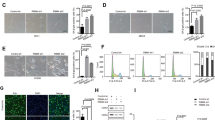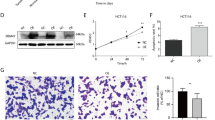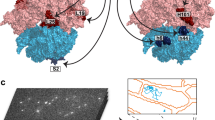Abstract
Hypoxia and other adverse conditions are commonly encountered by rapidly growing cells. The RNA-binding protein RBM3 (RNA-binding motif protein 3), which is transcriptionally induced by low temperature and hypoxia, has recently been implicated in survival of colon cancer cells by mechanisms involving cyclooxygenase-2 (COX-2) signaling. Immunohistochemically, we found strong RBM3 expression in a variety of malignant and proliferating tissues but low expression in resting and terminally differentiated cells. RBM3 expression in fibroblasts and human embryonal kidney (HEK293) cells subjected to serum deprivation or contact inhibition closely paralleled proliferation rates, assessed by real-time RT-PCR and immunoblotting. siRNA-mediated RBM3 knockdown reduced cell viability and finally led to cell death, which did not involve caspase-3-mediated apoptosis, cell cycle arrest, or COX-2 regulation. In contrast, RBM3 over-expression rescued cells from death under serum starvation. This was associated with increased translation rates, as measured by 14C serine and 3H phenylalanine incorporation. Together, RBM3 is a critical factor providing cellular survival advantages in an adverse microenvironment presumably by restoring translation efficacy.
Similar content being viewed by others
Log in or create a free account to read this content
Gain free access to this article, as well as selected content from this journal and more on nature.com
or
Abbreviations
- COX-2:
-
cyclooxygenase-2
- HEK293:
-
human embryonal kidney
- HT29:
-
human colon adenocarcinoma cells
- K562:
-
human chronic myeloid leukemia cells
- MTA:
-
multitissue Array
- RBM3:
-
RNA-binding motif protein 3
References
Derry JM, Kerns JA, Francke U 1995 RBM3, a novel human gene in Xp11.23 with a putative RNA-binding domain. Hum Mol Genet 4: 2307–2311
Wellmann S, Buhrer C, Moderegger E, Zelmer A, Kirschner R, Koehne P, Fujita J, Seeger K 2004 Oxygen-regulated expression of the RNA-binding proteins RBM3 and CIRP by a HIF-1-independent mechanism. J Cell Sci 117: 1785–1794
Danno S, Nishiyama H, Higashitsuji H, Yokoi H, Xue JH, Itoh K, Matsuda T, Fujita J 1997 Increased transcript level of RBM3, a member of the glycine-rich RNA-binding protein family, in human cells in response to cold stress. Biochem Biophys Res Commun 236: 804–807
Danno S, Itoh K, Matsuda T, Fujita J 2000 Decreased expression of mouse Rbm3, a cold-shock protein, in Sertoli cells of cryptorchid testis. Am J Pathol 156: 1685–1692
Williams DR, Epperson LE, Li W, Hughes MA, Taylor R, Rogers J, Martin SL, Cossins AR, Gracey AY 2005 Seasonally hibernating phenotype assessed through transcript screening. Physiol Genomics 24: 13–22
Dresios J, Aschrafi A, Owens GC, Vanderklish PW, Edelman GM, Mauro VP 2005 Cold stress-induced protein Rbm3 binds 60S ribosomal subunits, alters microRNA levels, and enhances global protein synthesis. Proc Natl Acad Sci USA 102: 1865–1870
Kita H, Carmichael J, Swartz J, Muro S, Wyttenbach A, Matsubara K, Rubinsztein DC, Kato K 2002 Modulation of polyglutamine-induced cell death by genes identified by expression profiling. Hum Mol Genet 11: 2279–2287
Cok SJ, Acton SJ, Sexton AE, Morrison AR 2004 Identification of RNA-binding proteins in RAW 264.7 cells that recognize a lipopolysaccharide-responsive element in the 3-untranslated region of the murine cyclooxygenase-2 mRNA. J Biol Chem 279: 8196–8205
Sureban SM, Ramalingam S, Natarajan G, May R, Subramaniam D, Bishnupuri KS, Morrison AR, Dieckgraefe BK, Brackett DJ, Postier RG, Houchen CW, Anant S 2008 Translation regulatory factor RBM3 is a proto-oncogene that prevents mitotic catastrophe. Oncogene 27: 4544–4556
Buhrer C, Berlin C, Thiele HG, Hamann A 1990 Lymphocyte activation and expression of the human leucocyte-endothelial cell adhesion molecule 1 (Leu-8/TQ1 antigen). Immunology 71: 442–448
Wellmann S, Bettkober M, Zelmer A, Seeger K, Faigle M, Eltzschig HK, Buhrer C 2008 Hypoxia upregulates the histone demethylase JMJD1A via HIF-1. Biochem Biophys Res Commun 372: 892–897
Shalapour S, Zelmer A, Pfau M, Moderegger E, Costa-Blechschmidt C, van Landeghem FK, Taube T, Fichtner I, Buhrer C, Henze G, Seeger K, Wellmann S 2006 The thalidomide analogue, CC-4047, induces apoptosis signaling and growth arrest in childhood acute lymphoblastic leukemia cells in vitro and in vivo. Clin Cancer Res 12: 5526–5532
Janz M, Hummel M, Truss M, Wollert-Wulf B, Mathas S, Johrens K, Hagemeier C, Bommert K, Stein H, Dorken B, Bargou RC 2006 Classical Hodgkin lymphoma is characterized by high constitutive expression of activating transcription factor 3 (ATF3), which promotes viability of Hodgkin/Reed-Sternberg cells. Blood 107: 2536–2539
Willard HF, Ambani LM, Hart AC, Mahoney MJ, Rosenberg LE 1976 Rapid prenatal and postnatal detection of inborn errors of propionate, methylmalonate, and cobalamin metabolism: a sensitive assay using cultured cells. Hum Genet 34: 277–283
Gerstner B, Buhrer C, Rheinlander C, Polley O, Schuller A, Berns M, Obladen M, Felderhoff-Mueser U 2006 Maturation-dependent oligodendrocyte apoptosis caused by hyperoxia. J Neurosci Res 84: 306–315
Kononen J, Bubendorf L, Kallioniemi A, Barlund M, Schraml P, Leighton S, Torhorst J, Mihatsch MJ, Sauter G, Kallioniemi OP 1998 Tissue microarrays for high-throughput molecular profiling of tumor specimens. Nat Med 4: 844–847
Glisovic T, Bachorik JL, Yong J, Dreyfuss G 2008 RNA-binding proteins and post-transcriptional gene regulation. FEBS Lett 582: 1977–1986
Burdon RH 1987 Temperature and animal cell protein synthesis. Symp Soc Exp Biol 41: 113–133
Hochachka PW, Buck LT, Doll CJ, Land SC 1996 Unifying theory of hypoxia tolerance: molecular/metabolic defense and rescue mechanisms for surviving oxygen lack. Proc Natl Acad Sci USA 93: 9493–9498
Iyer VR, Eisen MB, Ross DT, Schuler G, Moore T, Lee JC, Trent JM, Staudt LM, Hudson J Jr, Boguski MS, Lashkari D, Shalon D, Botstein D, Brown PO 1999 The transcriptional program in the response of human fibroblasts to serum. Science 283: 83–87
Chang HY, Sneddon JB, Alizadeh AA, Sood R, West RB, Montgomery K, Chi JT, van de Rijn M, Botstein D, Brown PO 2004 Gene expression signature of fibroblast serum response predicts human cancer progression: similarities between tumors and wounds. PLoS Biol 2: E7
Cam H, Balciunaite E, Blais A, Spektor A, Scarpulla RC, Young R, Kluger Y, Dynlacht BD 2004 A common set of gene regulatory networks links metabolism and growth inhibition. Mol Cell 16: 399–411
Zeng Y, Kulkarni P, Inoue T, Getzenberg RH 2009 Down-regulating cold shock protein genes impairs cancer cell survival and enhances chemosensitivity. J Cell Biochem 107: 179–188
Acknowledgements
We are grateful to Barbara Stalder, Molecular Pathology Section, Institute of Pathology, Basel University Hospital, for production of the tissue array and excellent performance of immunohistochemical procedures. We thank Dr. Terttu Suormala for expert technical assistance in determination of protein synthesis, Metabolic Unit, University Children's Hospital, Basel.
Author information
Authors and Affiliations
Corresponding author
Additional information
Supported by grants from the Wilhelm-Sander-Foundation (2004.162.1), Munich, Germany, and the Bangerter-Rhyner-Foundation, Bern, Switzerland.
Rights and permissions
About this article
Cite this article
Wellmann, S., Truss, M., Bruder, E. et al. The RNA-Binding Protein RBM3 Is Required for Cell Proliferation and Protects Against Serum Deprivation-Induced Cell Death. Pediatr Res 67, 35–41 (2010). https://doi.org/10.1203/PDR.0b013e3181c13326
Received:
Accepted:
Issue date:
DOI: https://doi.org/10.1203/PDR.0b013e3181c13326
This article is cited by
-
Transcriptional sequencing analysis reveals the potential use of deer antler for “tonifying the kidney and strengthening bone”
Journal of Orthopaedic Surgery and Research (2022)
-
Pre-clinical and clinical studies on the role of RBM3 in muscle-invasive bladder cancer: longitudinal expression, transcriptome-level effects and modulation of chemosensitivity
BMC Cancer (2022)
-
3D microenvironment attenuates simulated microgravity-mediated changes in T cell transcriptome
Cellular and Molecular Life Sciences (2022)
-
Mild hypothermia ameliorates hepatic ischemia reperfusion injury by inducing RBM3 expression
Apoptosis (2022)
-
Autism risk gene KMT5B deficiency in prefrontal cortex induces synaptic dysfunction and social deficits via alterations of DNA repair and gene transcription
Neuropsychopharmacology (2021)



